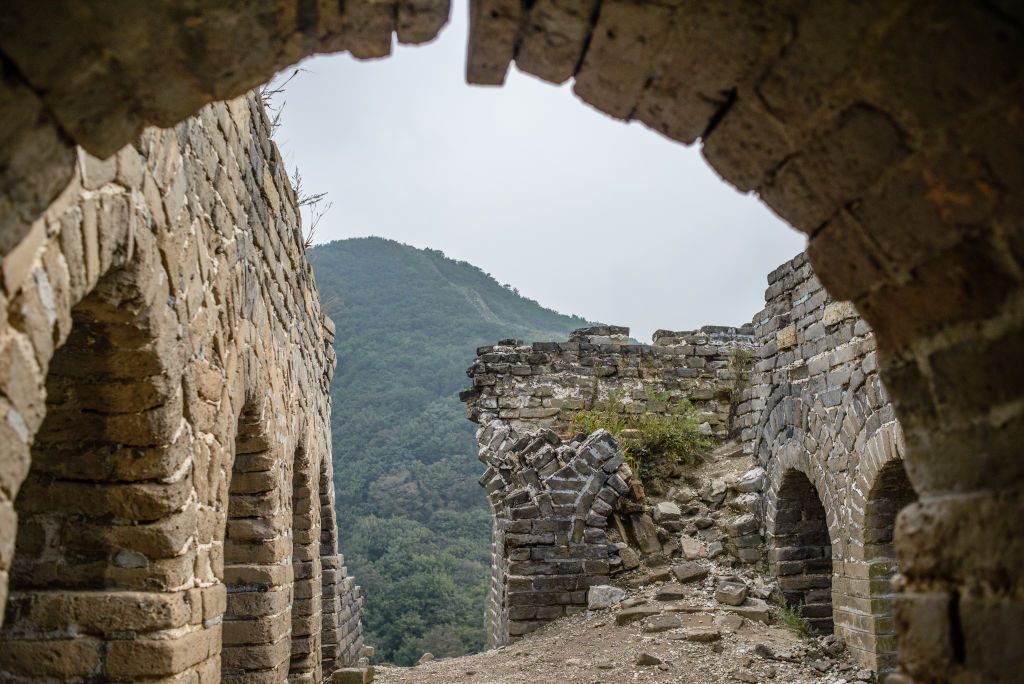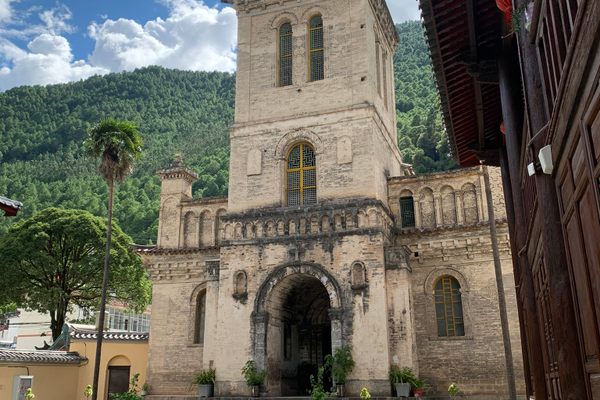Ancient Chinese Buildings Are Held Together With Rice, Sugar, and Blood
Edible additives in mortar served both practical and philosophical purposes.

The city wall of Nanjing, built 600 years ago, was the first line of defense for the founding capital of the Ming dynasty. Originally 22 miles long, it was built with 350 million bricks, most of which have survived centuries of weathering. In 2010, intrigued by the wall’s sturdy composition, a team of Chinese researchers analyzed mortar samples from one section. The secret ingredient turned out to be humble sticky rice, a staple of Chinese cuisine.
This use of gummy grains as an adhesive is not entirely surprising. For thousands of years, Chinese builders mixed sticky rice, or glutinous rice, with lime mortar to assemble structures across the country, including city walls, pagodas, bridges, and tombs. Cooked rice was first boiled into a paste, then blended with sand and lime, a substance produced by heating limestone. According to researchers Yan-Bing Luo and Yu-Jie Zhang of Sichuan University, this starchy concoction “holds important status and value in Chinese architectural history.” Because of its strength and low porosity, they refer to it as “Chinese concrete.”
Scientists have long been fascinated with this unusual formula, and in recent years, different teams have conducted studies to better understand it. Researchers Jiajia Li and Bingjian Zhang spent six years collecting 378 samples of ancient mortar from 159 sites throughout China, dating from the Taosi phase (2300-1900 BC) all the way to the late Qing dynasty (1644-1911). Their numerous chemical tests found that 219 mortars from 96 locations had “organic components”—that is, small traces of starch, protein, brown sugar, blood, and oil. These mixtures have helped preserve much of China’s built landscape. As the researchers write, “the quality of mortar used in construction has played an important role in determining monument durability.”

One notable sample, from a 2000-year-old tomb in Jiangsu province, turned up what the researchers say is the oldest known trace of sticky rice mortar. (A separate study identified an earlier use, dating to three thousand years ago.) While the researchers don’t know the recipe’s origin story, they determined that by the Tang dynasty (816-907), rice was often used to improve construction. By the Song and Ming dynasties, both periods of extensive architectural activity, this unique mortar was prevalent, especially in the foundations of important buildings.
Sticky rice is sweet, and augments savory dishes such as zongzi, pyramids of rice and fillings neatly wrapped in leaves, or tang yuan, a sweet soup with rice dumplings. It is also waxy—a texture that comes from the polysaccharide amylopectin, which gives the rice a denser microstructure. Mixed with lime mortar, the grains boost compressive strength, helping walls bear loads without fracturing. They are also highly water resistant, which protects buildings against erosion.
Mortar samples from halls and the garden of the famed Forbidden City, built in the 15th century, tested positive for the starch. So did sections of the Great Wall of China, which was largely restored during the Ming dynasty. But one sample from the Wall, where it runs through Yanqing County, contained a less common ingredient: animal blood, which showed up in just five sites.

Animal blood might sound like a grisly substance for building walls, but it was a perfectly normal additive used by several cultures. Historical recipes written in French, Italian, and English have detailed ways to mix oxblood and lime mortars. In China, builders used pig blood to improve the consistency of their mortar, according to a 2014 study. It is also easily available, resulting in diverse regional dishes such as pork blood soup and pig blood curd.
Many other organic additives favored by the Chinese helped repel water. Li and Zhang found oil samples from 87 sites, which they believe to be tung oil, a common waterproof seal for wooden ships. Another, egg white, is not only water resistant but also improves the viscosity of mortar. (Eggs whites were also used as a paint binder to color the famous Terracotta Army.) Researchers have found that brown sugar, too, reduces water content in mortars, enhancing their strength. According to ancient literature, sucrose was often used to build forts and homes in eastern and southeastern China.
These mortars were also likely invented out of necessity. In distant Rome, the secret ingredient of concrete was volcanic ash, which improved the durability of lime mortar and enabled it to set underwater. Similar mortars made with volcanic ash were adopted throughout Europe and western Asia; however, volcanic ash was not available in ancient China. Instead, engineers would have used their own regional ingredients to create distinctive building materials. Other innovative mortars have similarly developed out of convenience, from a church in the Philippines made of egg whites to a Brazilian chapel held together by wine.

Great design is often the result of thinking beyond form and function. Philosophy, the researchers posit, might be one poetic inspiration for these fusion pastes. “Ancient Chinese people advocated a view of nature often termed ‘heaven-and-human oneness,’” Li and Zhang write. “The use of agricultural, forestry, and animal products in building materials reflected architectural aesthetics that sought to integrate architecture and nature.”
Incredibly, structures built with sticky rice mortar have survived more than natural erosion. A Ming tomb, of the minister Xu Pu and his wife, was nearly damaged by a bulldozer when found in 1978, but it was “so firm [the vehicle] could do nothing about it,” according to a 2009 paper. Its three authors describe another near-miracle: in 1604, when a 7.5-magnitude earthquake shook the port city of Quanzhou, many temples, stupas, and bridges were not destroyed. Instead, sticky rice mortar kept their foundations firmly secured.
Although clearly effective, these revolutionary adhesives fell out of fashion in the late Qing dynasty. Li and Zhang note that China’s first cement factory opened in 1889 in Hebei province, and this inorganic binder gradually filled the role of composite mortars.

But researchers still see potential in these ancient formulas, especially to stabilize historical sites. Cement is detrimental to conservation work, writes Dr. Gaetano Palumbo, an archaeologist with the University College London. It “contains high quantities of salts and is incompatible (being too strong and rigid) with traditional lime-based mortars.” In China, restorers successfully used sticky rice-lime mortars to mend ancient structures, such as the single-arch Shouchang Bridge from the Song dynasty.
One group of conservationists is combining the timeworn technology of sticky rice with relatively new nanotechnology to develop an innovative treatment for historical sites. “This is an original and ecologic application that can be used to repair any lime-based structure, such as limestone or a lime mortar,” says Jorge Otero, a researcher with the Getty Conservation Institute. His team is still testing the durability of their materials, but the capabilities of the ancient grain are evident. Soon, glutinous rice may glue together historical buildings around the world.
Gastro Obscura covers the world’s most wondrous food and drink.
Sign up for our regular newsletter.











































Follow us on Twitter to get the latest on the world's hidden wonders.
Like us on Facebook to get the latest on the world's hidden wonders.
Follow us on Twitter Like us on Facebook